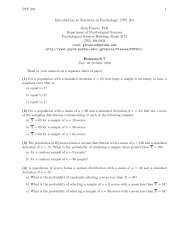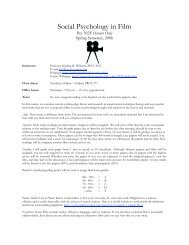Introduction to Statistics in Psychology: PSY 201 - Department of ...
Introduction to Statistics in Psychology: PSY 201 - Department of ...
Introduction to Statistics in Psychology: PSY 201 - Department of ...
You also want an ePaper? Increase the reach of your titles
YUMPU automatically turns print PDFs into web optimized ePapers that Google loves.
<strong>PSY</strong> <strong>201</strong> 4<br />
(14) Numerous studies have shown that IQ scores have been <strong>in</strong>creas<strong>in</strong>g, generation by generation,<br />
for years (Flynn, 1984, 1999). The <strong>in</strong>crease is called the Flynn Effect, and the data <strong>in</strong>dicate that the<br />
<strong>in</strong>crease appears <strong>to</strong> be about 7 po<strong>in</strong>ts per decade. To demonstrate this phenomenon, a researcher<br />
obta<strong>in</strong>s an IQ test that was written <strong>in</strong> 1980. At the time the test was prepared, it was standardized<br />
<strong>to</strong> produce a population mean <strong>of</strong> µ = 100. The researcher adm<strong>in</strong>isters the test <strong>to</strong> a random sample<br />
<strong>of</strong> n = 16 <strong>of</strong> <strong>to</strong>day’s high school students and obta<strong>in</strong>s a sample mean IQ <strong>of</strong> X = 121 with s = 6.32.<br />
Is this result sufficient <strong>to</strong> conclude that <strong>to</strong>day’s sample scored significantly higher than would be<br />
expected from a population with µ = 100 Use a one-tailed test with α = 0.01.







![Exam 4 Study Guide[1]](https://img.yumpu.com/45196739/1/190x245/exam-4-study-guide1.jpg?quality=85)







